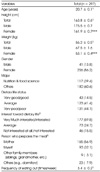1. Ahn Y, Ko SY, Kim KW. Evaluation of a nutrition education program for elementary school children. Korean J Community Nutr. 2009. 14(3):266–276.
2. Ahn YK, Ro HK. A survey on preferences for vegetable cooking methods and vegetable-aversion-related factors among elementary school students in Kwangju and Chonnam regions. Korean J Community Nutr. 2009. 14(5):531–544.
3. Bandura A. Foundations of thought and action: A social cognitive theory, Prentice-Hall, Englewood Cliffs, NJ, USA. 1986.
4. Cho HS, Kim MH, Choi MK. A study on vegetable intakes and dietary habits of middle school students in Chungnam. Korean J Community Nutr. 2010. 15(4):525–535.
5. Choi MY, Kim HY. Nutrition knowledge, dietary self-efficacy and eating habits according to student's stage of regular breakfast or exercise. Korean J Community Nutr. 2008. 13(5):653–662.
6. Contento IR. Nutrition education - Linking research, theory, and practice. 2007. Sudbury, MA, USA: Jones and Barlett Publishers.
7. Hong HO, Lee JS. Survey on Korean food preference of college students in Seoul - focused on the staple food and snack -. Korean J Nutr. 2006. 39(7):699–706.
8. Hwang JH, Lee HM. A study on lifestyles, dietary habits, nutrition knowledge and dietary behaviors of male university students according to residence type. Korean J Community Nutr. 2007. 12(4):381–395.
9. Jang HB, Lee HW, Han YH, Song JH, Kim KN, Hyun TS. Changes in food and nutrient intakes of college students between 1999 and 2009. Korean J Community Nutr. 2011. 16(3):324–336.
10. Janis IL, Mann L. Decision making-A psychological analysis of conflict, choice and commitment. 1977. New York: free press.
11. Kang HJ, Byun KW. Effect of two-year course of food and nutrition on improving nutrition knowledge, dietary attitudes and food habits of junior college female students. Korean J Community Nutr. 2010. 15(6):750–759.
12. Kang JY, Kim SY, Lee MS, Ahn HS. Effect of vegetable juice supplementation on serum lipid profile and antioxidant activity in college women. Korean J Community Nutr. 2005. 10(2):183–188.
13. Kim KH. A study of the dietary habits, the nutritional knowledge and the consumption patterns of convenience foods of university students in the Gwangju area. Korean J Community Nutr. 2003. 8(2):181–191.
14. Kim KW, Ahn Y, Kim HM. Fast food consumption and related factors among university students in Daejeon. Korean J Community Nutr. 2004. 9(1):47–57.
15. Ko MS. The comparison in daily intake of nutrients and dietary habits of college students in Busan. Korean J Community Nutr. 2007. 12(3):259–271.
16. Korean Nutrition Society. Dietary reference intakes for Koreans. 2010. 530–535.
17. Ku UH, Seo JS. The status of nutrient intake and factors related to dislike of vegetables in elementary school students. Korean J Community Nutr. 2005. 10(2):151–162.
18. Kwon SY, Han JI, Chung YJ. Relationship of nutritional knowledge, dietary self efficacy and change of dietary behavior of nutrition professional. Korean J Nutr. 2008. 41(6):550–560.
19. Lee JS, Ha BJ. A study of the dietary attitude, dietary self-efficacy and nutrient intake among middle school students with different obesity indices in Gyeong-nam. Korean J Community Nutr. 2003. 8(2):171–180.
20. Lee KA, Jeong BY, Moon SK, Kim IS, Nakamura S. Comparisons of Korean adults' eating habits, food preferences and nutrient intake by generation. Korean J Nutr. 2006. 39(5):494–504.
21. Chuan Ling AM, Horwath C. Perceived benefits and barriers of increased fruit and vegetable consumption: validation of a decisional balance scale. J Nutr Educ. 2001. 33(5):257–265.
22. Na SY, Ko SY, Eom SH, Kim KW. Intakes and beliefs of vegetables and fruits, self-efficacy, nutrition knowledge, eating behavior of elementary school students in Kyunggi area. Korean J Community Nutr. 2010. 15(3):329–341.
23. Ministry of Health and Welfare. Korean Health Statistics 2009 - Korea National Health and Nutrition Examination Survey (KNHANES -3). 2010.
24. Park MS, Kim SA. Effect of nutrition education on improving diet behavior of university students. Korean J Community Nutr. 2005. 10(2):189–195.
25. Prochaska JO, Diclemente CC. Stage and process of self-change in smoking - Towards an integrative model of change. J Consult Clin Psychol. 1983. 51:390–395.
26. Prochaska JO, Redding CA, Evers KE. Glanz K, Rimer BK, Viswanath K, editors. The transtheoretical model and stages of change. Health behavior and health education. 2008. 4th ed. CA: Jossey-Bass;97–108.
27. Shaikh AR, Yaroch AL, Nebeling L, Yeh MC, Resnicow K. Psychosocial predictors of fruit and vegetable consumption in adults - a review of the literature. Am J Prev Med. 2008. 34(6):535–543.
28. Sorensen G, Stoddard AM, Dubowitz T, Barbeau EM, Bigby J, Emmons KM, Berkman LF, Peterson KE. The influence of social context on change in fruit and vegetable consumption -results of the healthy directions studies. Am J Public Health. 2007. 97(7):1216–1227.
29. Suh YS, Chung YG. Comparison of mineral and vitamin intakes according to the stage of change in fruit and vegetable intake for elementary school students in Chungnam province. Korean J Nutr. 2008. 41(7):658–666.
30. Suh YS, Chung YG. The effect of nutrition education on the improvement of psychosocial factors related to vegetable and fruit intake of elementary school children in pre-action stage. Korean J Nutr. 2010. 43(6):597–606.
31. Thompson VJ, Bachman CM, Baranowski T, Cullen KW. Self-efficacy and norm measures for lunch fruit and vegetable consumption are reliable and valid among fifth grade students. J Nutr Educ Behav. 2007. 39(1):2–7.
32. Wolf RL, Lepore SJ, Vandergrift JL, Wetmore-Arkader L, Mcginty E, Pietrzak G, Yaroch AL. Knowledge, barriers, and stage of change as correlates of fruit and vegetable consumption among urban and mostly immigrant black men. J Am Diet Assoc. 2008. 108(8):1315–1322.







 PDF
PDF ePub
ePub Citation
Citation Print
Print





 XML Download
XML Download